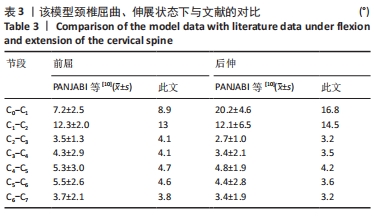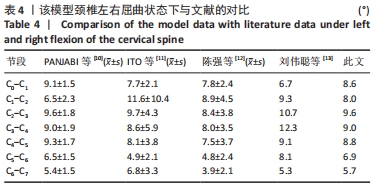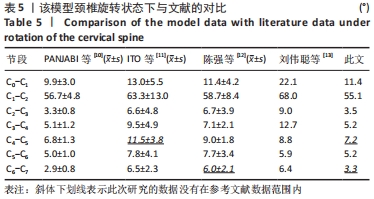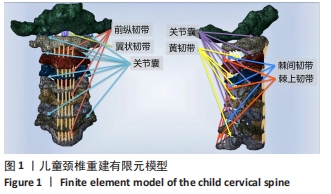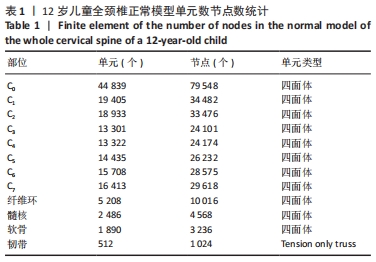中国组织工程研究 ›› 2023, Vol. 27 ›› Issue (4): 500-504.doi: 10.12307/2022.994
• 骨与关节生物力学 bone and joint biomechanics • 上一篇 下一篇
CT数据建立12岁儿童全颈椎有限元模型及有效性验证
刘清华1,蔡永强2,金 凤3,于静红4,王海燕5,张云凤4,王利东6,李佳伟1,王 星5,和雨洁5,戴丽娜5,王建忠5,邬 超1,仝 铃1,康志杰1,李志军2,5,李筱贺5
- 内蒙古医科大学,1研究生院,2数字医学中心(内蒙古自治区数字转化医学工程技术研究中心),5人体解剖教研室,内蒙古自治区呼和浩特市 010000;3内蒙古医科大学附属医院影像科,内蒙古自治区呼和浩特市 010000;4内蒙古医科大学第二附属医院影像科,内蒙古自治区呼和浩特市 010000;6内蒙古自治区国际蒙医医院影像科,内蒙古自治区呼和浩特市 010000
Finite element model of the 12-year-old child whole cervical spine: establishment and validity verification based on CT data
Liu Qinghua1, Cai Yongqiang2, Jin Feng3, Yu Jinghong4, Wang Haiyan5, Zhang Yunfeng4, Wang Lidong6, Li Jiawei1, Wang Xing5, He Yujie5, Dai Lina5, Wang Jianzhong5, Wu Chao1, Tong Ling1, Kang Zhijie1, Li Zhijun2, 5, Li Xiaohe5
- 1Graduate School, 2Digital Medicine Center (Digital Translational Medicine Engineering Technology Research Center of Inner Mongolia Autonomous Region), 5Department of Human Anatomy, Inner Mongolia Medical University; 3Department of Imaging, Affiliated Hospital of Inner Mongolia Medical University; 4Department of Imaging, the Second Affiliated Hospital of Inner Mongolia Medical University, Hohhot 010000; 6Department of Imaging, Inner Mongolia International Mongolian Hospital, Hohhot 010000
摘要:
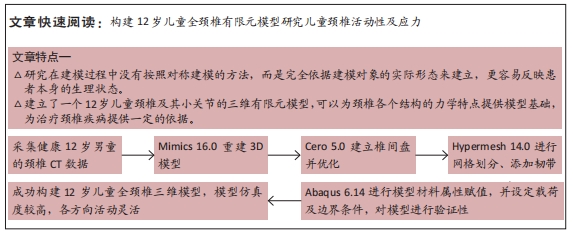
文题释义:
全颈椎有限元模型:是指基于CT扫描获取的颈椎数据,通过医学图像处理软件以及有限元软件建立的包含小关节、椎间盘以及部分韧带的儿童全颈椎模型。
有限元模型分析法:是近年来研究人体生物力学的有效方法,其基本原理是把连续的物体离散为一组有限个、按一定方式相互联结在一起的单元组合体,然后求其相互之间的关系及特征,是一种化整为零、集零为整的方法。
背景:儿童颈椎有限元模型多为10岁及以下儿童的,所建立的节段也只是部分颈椎,而12岁儿童全颈椎有限元模型则相对较少。
目的:建立有效的12岁儿童全颈椎有限元模型,为研究儿童颈椎活动性、应力及临床治疗儿童颈椎疾病提供理论依据。
方法:随机选择 1名健康的12岁儿童,使用64排螺旋CT对该儿童颈椎进行扫描,将CT数据导入Mimics 16.0 中重建简单的三维模型,用 Cero 5.0优化模型,再导入Hypermesh 14.0中划分网格及添加韧带,最后用ANSYS 6.14软件进行材料赋值,设定边界等操作,构建颈椎三维有限元模型,并对模型有效性进行验证,将模型在前屈后伸、左右屈曲、左右旋转6种工况下各椎体的活动度与文献数据进行对比。
结果与结论:通过有限元软件成功建立了12岁儿童全颈椎三维有限元模型,该模型还原度高,与其模拟的颈椎相似性好。在1.5 N•m的载荷下,除C4-5、C6-7在旋转工况下的活动度较参考文献低外,其余节段在各种工况下的活动度均在既往文献的参考范围内,说明该模型有效,在后续的应力研究和临床治疗中可以运用。
https://orcid.org/0000-0003-0279-2710 (刘清华) ;https://orcid.org/0000-0002-5009-1591 (蔡永强)
中国组织工程研究杂志出版内容重点:人工关节;骨植入物;脊柱;骨折;内固定;数字化骨科;组织工程
中图分类号:
